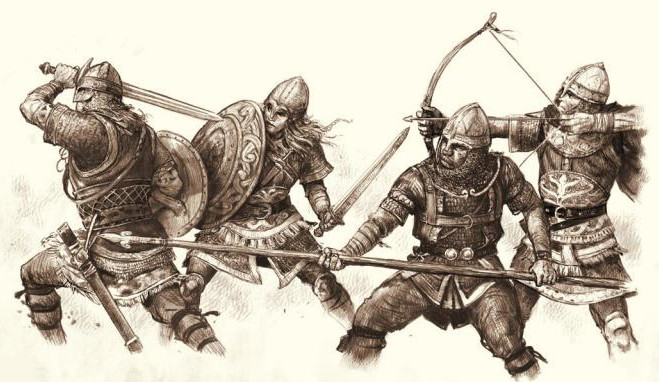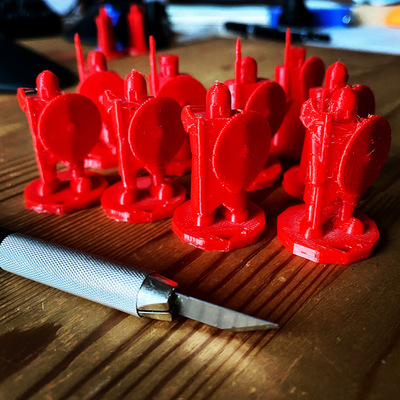
|
Target Number Eriador |
| 2022-01-25 |
Target Number Eriador
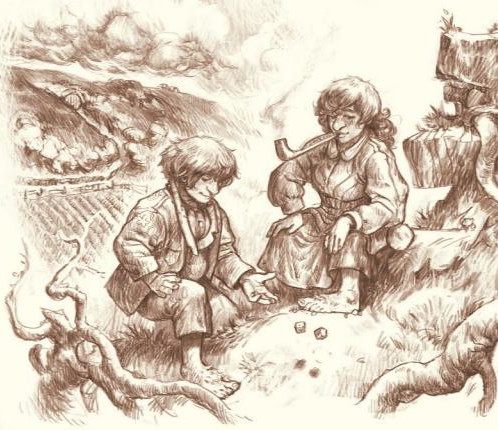
The One Ring. The first impression? Symbaroum, since the cover art and the chapter head art is by Martin Grip. The second impression? Trudvang, because a good part of the inner art is by Alvaro Tapia. But these are just impressions. Cover art, inner art, layout and all drew me to Eriador in the years after Bilbo's return.
I know nothing The One Ring first edition, but The One Ring RPG 2nd Edition is a post that looks at the 2nd edition and its distance to the 1st edition. Warmly recommended as this point of view makes for a good introduction to The One Ring and the game it tries to be.
I haven't tried the game since I have just received it. Here are a few highlights I gleaned through a first read. My first impressions are detailed above and they were key in driving me towards the text, I was enticed by the art and the text felt easy to read.
Let me first quote the Playing the Game section:
The One Ring is what we call a pen-and-paper roleplaying game. Thanks to video and online games, millions of people are familiar with this form of entertainment, where players create fictional heroes and explore shared worlds populated by computer-controlled creatures and, in online games, accessed by a multitude of other players.
In The One Ring, players create characters and meet face-to-face around a table or across the world on video, and the computer is replaced by one person taking the mantle of the Loremaster — a director, a referee, and a narrator.
The game can be played with as few as two people (one player plus the Loremaster), and with as many as six players or more. All that is needed are dice, paper, pencils, imagination, and a love for Tolkien's imaginary world.
I like their concision and how the Loremaster is introduced.
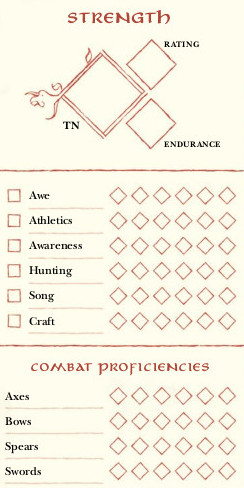
Why did I write Target Number in the title of this post? See the TN large square under Strength. Each character in The One Ring has three attributes: Strength, Heart, and Wits. The attribute rating is a number between 2 and 7 and is determined by the Heroic Culture the Player-Hero belongs to (Bardings, Dwarves of Durin's Folk, Elves of Lindon, Hobbits of the Shire, Men of Bree, or Rangers of the North).
The TN (Target Number) is 20 - rating. When attempting an action that is dangerous, that aims to obtain information not immediately available, or that intends to influence uncooperative Loremaster's characters, dice are rolled and success is obtained if sum reaches the TN or higher.
What dice? Well, a Feat Die and as many Success Dice as there are boxes checkes right of the skill involved. A Feat Dice is a special d12 (11 is the Eye of Sauron, while 12, is Gandalf's Rune), and a Success Dice is a plain d6 (although with a success rune on the 6 side.
If my Strength rating is 6, my Strength TN is 14 (20 - 6). If I have two checks in Athletics and I try to jump over a crevice, I might propose the Loremaster to roll 1d12 + 2d6 against 14. In normal circumstances, the Eye of Sauron counts as 0, and the Gandalf Rune as an overriding success, whatever the sum.
If the roll is successful and one success icon (6 on a d6) turns up, the success is considered a great success, if two or more success icons turn up, it is an extraordinary success. Players may optionally spend those success icons to cancel a failure (if the skill roll is multi player, lets another player succeed at their roll), gain insight (further information or insight is gleaned while at the successful task), go quietly (the task is done noiselessly or without drawing attention, widen influence (the task affects a wider area or more elements than a normal success), etc...
Each skill as a square left of its name on the character sheet. It is checked if it's a favoured skill of the character. A favoured roll is a roll with two feat dice (the best is kept). Should the player-hero suffer a limitation, the roll might be ill-favoured, two feat dice again but the worst is kept. Like with 5e advantage favour and ill-favour cancel each other.
There is another way to add to a roll, via bonus success dice (d6). Characters may use Hope points to add success dice to their rolls. Should the circumstance grant inspiration to a character, each hope point invested result in two success dice added instead of one.
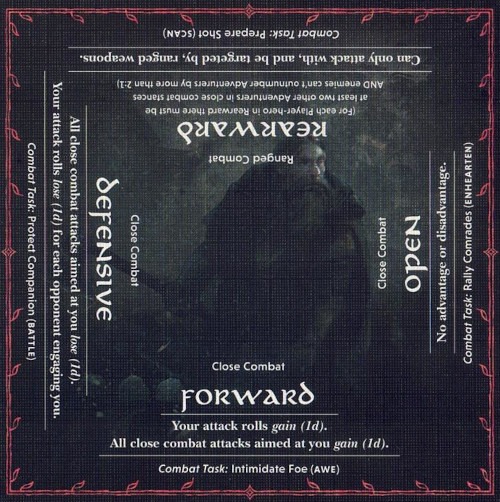
Combat happens in the usual Close Quarter Rounds, but it's preceded by an Opening Volleys phase, where bows are fired and spears thrown before mélêe starts. Should the distance separating the parties be large, the Loremaster might grant one more volley before the parties collide.
Each close combat quarter round happens in the following order: participants determine their Stance, the close combatant are then paired, then actions are resolved from combatants in Forward Stance to those in Rearward Stance (support fire).
A player-hero rolls their weapon skill against their Strength TN to determine if they hit. The target's Parry modifier is added to the Strength TN. For example, a ranger with two checks in their sword skill and a Strength TN of 14, must roll 1 Feat die and two Success dice against a TN of 14 + 2 against an Orc Guard.
An adversary doesn't roll against their Strength TN but against the Parry score of the target player-hero.
Should the attack succeed, the target loses a number of Endurance points equal to the weapon's Damage rating. For example, 5 for a long sword, or 7 for a great axe.
A player-hero may decide to half the damage they incur but get knocked back. Their next main action must then be spent recovering their fighting position.
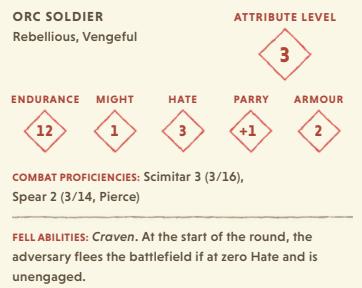
If an attack roll resulted in one or more success icons (sixes on the d6), they can be spent to trigger some special damage: a Heavy Blow, Fend Off, Pierce, or a Shield Thrust.
If an attack roll has a 10 or a Gandalf Rune on its feat dice or a success is spent to Pierce, it might result in a Piercing Blow. To determine if the blow results in a wound, a roll against the Injury rating of the weapon is done. One feat die plus as many success dice as the target armor dictates. For example, a spear held in one hand has an Injury rating of 14 and a mail shirt has a protection of 3 success dice.
The stance system, see the combat stance card image, seems to work with a theater of the mind approach and also with miniatures or tokens. It clearly identifies what a character does in combat.
Apart from the normal condition, player-heroes may suffer from three different conditions.
They get Miserable if the Shadow points they gathered exceed their Hope points. When a miserable character makes a roll, if the feat die lands on the Eye of Sauron, the action altogether fails.
They get Weary when their Endurance score gets lower than their Load score. In that condition, Success dice falling on 1, 2, 3 are accounted as 0 instead.
Wounded heroes staying active place themselves at great risk (especially in combat)
Here is a quick list of further things provided by The One Ring:
- Each adventurer has a calling, they are Captain, Champion, Messenger, Scholar, Treasure Hunter, and Warden; they provide favoured skills, an additional distinctive feature, and a Shadow Path;
- Distinction between adventure phase (adventures) and fellowship phase (downtime);
- Every three fellowship phases, the adventures spend the winter together, for a Yule fellowship phase (Last Christmas, I gave you my heart ♪);
- Distinctive features, a qualifier added to a player-hero that might be used to ask for Inspiration;
- There are combat tasks, as hinted by the combat stance card above, like Intimidate Foe, Rally Comrades, Protect Companion, etc;
- The seven pages about journeys, there is actually a travel sheet tracking the party members' fatigue and the events that happened;
- Councils, meetings held as a formal gathering, not the standard Meet the NPCs. They organize sequences of rolls to determine an outcome, likely one decisive for the adventuring party;
- The loremaster chapter of the core rules contains advice and suggestion for loremasters and especially Middle-Earth loremasters;
- The treasure section seems essential to keep reward flavour in check;
- The World chapter provides encounter tables for key Eriador locations;
- The appendix lists potential patrons (Bilbo, Gandalf, Balin, Círdan, Gilren, Tom Bombadil and Goldberry); it also lists landmarks;
- A nameless things generator closes the book, may prove useful in any roleplaying game.
The core rules and the starter set are beautiful. The game may provide a great experience, I wonder how hard it is to put one's feet in Tolkien boots, my MERP memories are foggy and I was only a player.
Again, I recommend reading the The One Ring RPG 2nd Edition post that goes strategic while my post stays technical, not even tactical.
